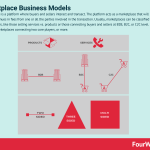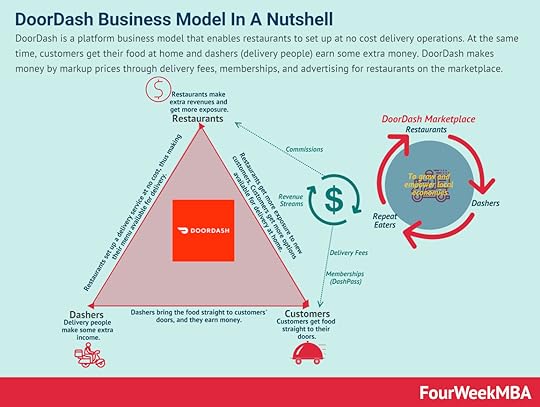Marketplace Business Models


A marketplace is a platform where buyers and sellers interact and transact. The platform acts as a marketplace that will generate revenues in fees from one or all the parties involved in the transaction. Usually, marketplaces can be classified in several ways, like those selling services vs. products or those connecting buyers and sellers at B2B, B2C, or C2C level. And those marketplaces connecting two core players, or more.
Different types of marketplacesBased on the kind of thing sold on the marketplace we can break them down into:
Service.Products.Based on the nature of the people or companies interacting though the marketplace we can break them down into:
B2B.B2C. C2C.Based on the number of players interacting and transacting on the platform, marketplaces can be broken down into:
Two-sided.Three-sided.Multi-sided.Marketplaces case studiesEtsy’s product marketplace Etsy is a two-sided marketplace for unique and creative goods. As a marketplace, it makes money via transaction fees on the items sold on the platform. Etsy’s key partner is comprised of sellers providing unique listings, and a wide organic reach across several marketing channels. Uber Eats three-sided marketplace
Etsy is a two-sided marketplace for unique and creative goods. As a marketplace, it makes money via transaction fees on the items sold on the platform. Etsy’s key partner is comprised of sellers providing unique listings, and a wide organic reach across several marketing channels. Uber Eats three-sided marketplace Uber Eats is a three-sided marketplace connecting a driver, a restaurant owner, and a customer with the Uber Eats platform at the center. The three-sided marketplace moves around three players: Restaurants pay commission on the orders to Uber Eats; Customers pay the small delivery charges, and at times, cancellation fee; Drivers earn through making reliable deliveries on time.LinkedIn two-sided marketplace
Uber Eats is a three-sided marketplace connecting a driver, a restaurant owner, and a customer with the Uber Eats platform at the center. The three-sided marketplace moves around three players: Restaurants pay commission on the orders to Uber Eats; Customers pay the small delivery charges, and at times, cancellation fee; Drivers earn through making reliable deliveries on time.LinkedIn two-sided marketplace LinkedIn for Business is used on a very large scale, around 30 million+ brands and businesses are using it. LinkedIn marketing tools available for each business size and sort, from small to large and B2B to B2C. LinkedIn is the most effective marketing tool not only for salespeople but also for brands and to build a strong corporate brand.Other marketplace business model case studiesAmazon Business Model
LinkedIn for Business is used on a very large scale, around 30 million+ brands and businesses are using it. LinkedIn marketing tools available for each business size and sort, from small to large and B2B to B2C. LinkedIn is the most effective marketing tool not only for salespeople but also for brands and to build a strong corporate brand.Other marketplace business model case studiesAmazon Business Model Amazon has a diversified business model. In 2019 Amazon posted over $280 billion in revenues and over $11.5 billion in net profits. Online stores contributed to over 50% of Amazon revenues, followed by Physical Stores, Amazon AWS, Subscription Services, Third-party Seller Services, and Advertising revenues.Doordash Business Model
Amazon has a diversified business model. In 2019 Amazon posted over $280 billion in revenues and over $11.5 billion in net profits. Online stores contributed to over 50% of Amazon revenues, followed by Physical Stores, Amazon AWS, Subscription Services, Third-party Seller Services, and Advertising revenues.Doordash Business Model DoorDash is a platform business model that enables restaurants to set up at no cost delivery operations. At the same time, customers get their food at home and dashers (delivery people) earn some extra money. DoorDash makes money by markup prices through delivery fees, memberships, and advertising for restaurants on the marketplace.Etsy Business Model
DoorDash is a platform business model that enables restaurants to set up at no cost delivery operations. At the same time, customers get their food at home and dashers (delivery people) earn some extra money. DoorDash makes money by markup prices through delivery fees, memberships, and advertising for restaurants on the marketplace.Etsy Business Model Etsy is a two-sided marketplace for unique and creative goods. As a marketplace, it makes money via transaction fees on the items sold on the platform. Etsy’s key partner is comprised of sellers providing unique listings, and a wide organic reach across several marketing channels.Uber Business Model
Etsy is a two-sided marketplace for unique and creative goods. As a marketplace, it makes money via transaction fees on the items sold on the platform. Etsy’s key partner is comprised of sellers providing unique listings, and a wide organic reach across several marketing channels.Uber Business Model  Uber is a is two-sided marketplace, a platform business model that connects drivers and riders, with an interface that has elements of gamification, that makes it easy for two sides to connect and transact. Uber makes money by collecting fees from the platform’s gross bookings.Uber Eats Business Model
Uber is a is two-sided marketplace, a platform business model that connects drivers and riders, with an interface that has elements of gamification, that makes it easy for two sides to connect and transact. Uber makes money by collecting fees from the platform’s gross bookings.Uber Eats Business Model Uber Eats is a three-sided marketplace connecting a driver, a restaurant owner and a customer with Uber Eats platform at the center. The three-sided marketplace moves around three players: Restaurants pay commission on the orders to Uber Eats; Customers pay the small delivery charges, and at times, cancellation fee; Drivers earn through making reliable deliveries on time.
Uber Eats is a three-sided marketplace connecting a driver, a restaurant owner and a customer with Uber Eats platform at the center. The three-sided marketplace moves around three players: Restaurants pay commission on the orders to Uber Eats; Customers pay the small delivery charges, and at times, cancellation fee; Drivers earn through making reliable deliveries on time.Read More: Platform Business Models, Network Effects, Etsy Business Model, Uber Eats Business Model, LinkedIn Business Model, Virtuous Cycle.
Read Also:
Business Strategy ExamplesBusiness ModelsWhat Is a Value Proposition?Business Model InnovationDigital Business ModelsThe post Marketplace Business Models appeared first on FourWeekMBA.



